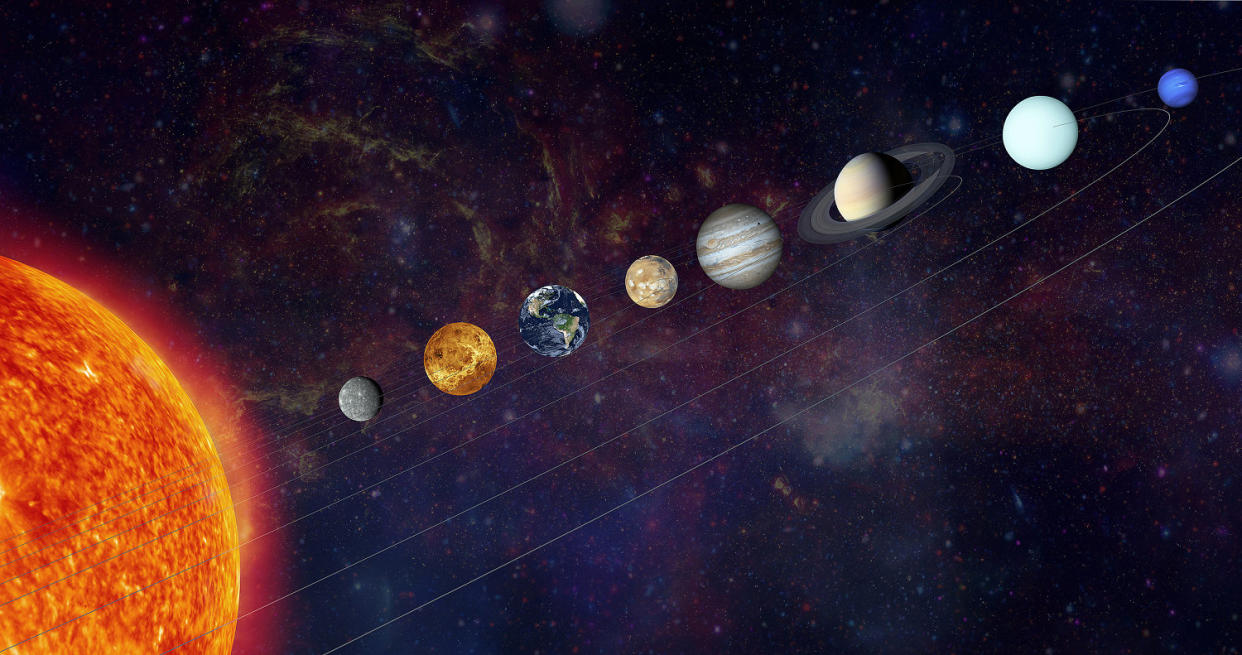Six planets will align in the night sky on June 3. How to see the 'planetary parade'

The cosmos has put on a show for us this spring, from the total solar eclipse in April that impacted the entire continental U.S. to the geomagnetic storm that led to northern lights in May.
Next up, a “parade of planets” will illuminate the sky.
Starting June 3, Mercury, Mars, Jupiter, Saturn, Uranus and Neptune will dazzle the sky as they near each other in the solar system, giving stargazers something special to look at in the morning.
Even though the view may be obscured by the sun and light pollution, astrologers — like me — say it will have astrological effects.
What is a 'parade of planets'?
A parade of planets occurs when several planets are visible in the night sky at once, and appear to form a line.
"The planets will orbit the sun in roughly the same plane (called the ecliptic plane), and at certain times, like we’ll see in June, their positions line up in a way that makes them look to us like they’re close together in the sky. It’s happening because of the specific orbital speeds and paths of the planets around the Sun," John Conafoy, CEO of Integrate Space, tells TODAY.com.
These alignments have different names depending on the number of stars visible.
Three planets constitutes a mini alignment.
Four planets are a small alignment, which we saw during April 8’s eclipse.
Large alignments, like the one we're seeing this June, contain five to six planets.
A great or full alignment includes all planets and occasionally Pluto.
When will June's 'parade of planets' take place?
The parade of planets starts on the morning of June 3.
How to actually see the parade of planets
The parade of planets will be visible throughout the northern hemisphere and will peak on June 3.
While there are six planets in play, we’ll only be able to view two easily with the naked eye, per NASA: Saturn and Mars.
The space agency explained that Jupiter and Mercury “won’t likely be visible because they’ll be at or below the horizon in morning twilight.”
If you want to use binoculars or a telescope, then you might catch a glimpse of Uranus and Neptune as well.
How do I know it's a planet, not a star?
There are a few key indicators you're looking at a planet and not a star. First, consider the twinkle. If it's not twinkling, then it's a planet.
"Planets look more like a steady light, while stars often twinkle because their light is affected by Earth’s atmosphere," Conafoy says.
Planets also might take on "distinctive colors," Conafoy says. Mars looks reddish, and Venus is more bright and white.
Finally, if you're a regular stargazer, you'll notice stars stay in similar fixed patterns whereas planets will move over days and weeks, Conafoy says.
When will the next planetary alignment occur?
There are few more celestial alignments coming up.
Aug. 28 will include the same six planets.
Jan. 18, 2025 will also include the same six planets.
Feb. 28, 2025 and Aug. 9, 2025 will have seven planets: Mercury, Venus, Mars, Jupiter, Saturn, Uranus and Neptune.
How will it affect us astrologically?
The “parade of planets” will bring lot of celestial energy to us earthlings.
Mercury moves into Gemini at 3:36 a.m. ET on June 3, making communication clear and concise.
Action planet Mars will be in Aries, philosopher Jupiter will be in Gemini, rule-maker Saturn will be in Pisces, revolutionary Uranus is in Taurus and dreamy Neptune will be in Pisces.
Together, the planets urge us to move towards our personal visions and communicate them freely to others. This will be a time in which we will be able to share our deepest secrets and desires — and we'll have a cosmic push to help make them a reality.
On June 3, the waning crescent moon will be in earthy Taurus, while the sun is in airy Gemini. We will feel curious about our goals and have the foundation needed to work toward them.
The following day, Venus and the sun power together in the “cazimi” effect, also known as the Venus star point (a phrase innovated by the astrologer Arielle Guttman). This offers yet another opportunity to discuss our aspirations, investments, work projects and relationships.
With the new moon in Gemini occurring on June 6, we are deciding what we want to keep and discard in every realm of our life, since it is a pivotal time for a fresh start. Think hard and contemplate these choices. They’re going to lead us towards our future.
Disclaimer: Astrology is not based in science. These posts are not intended to act as a directive
This article was originally published on TODAY.com

